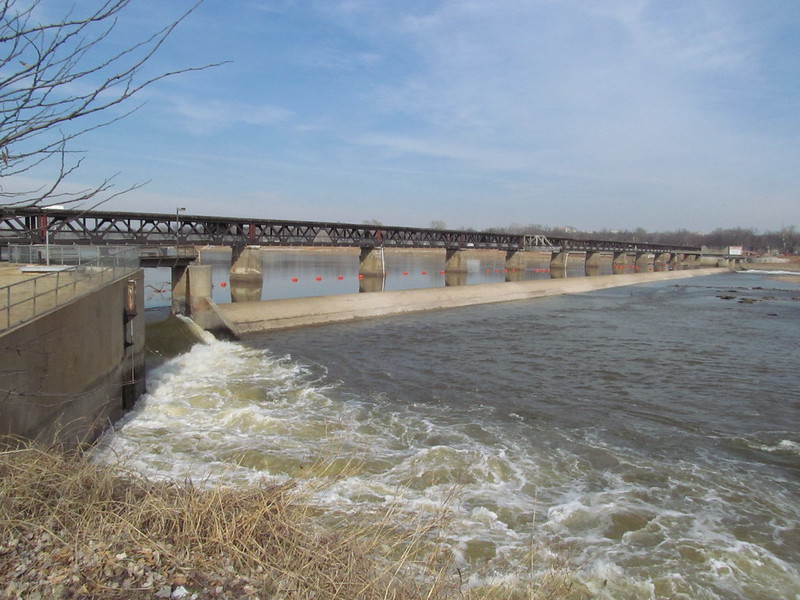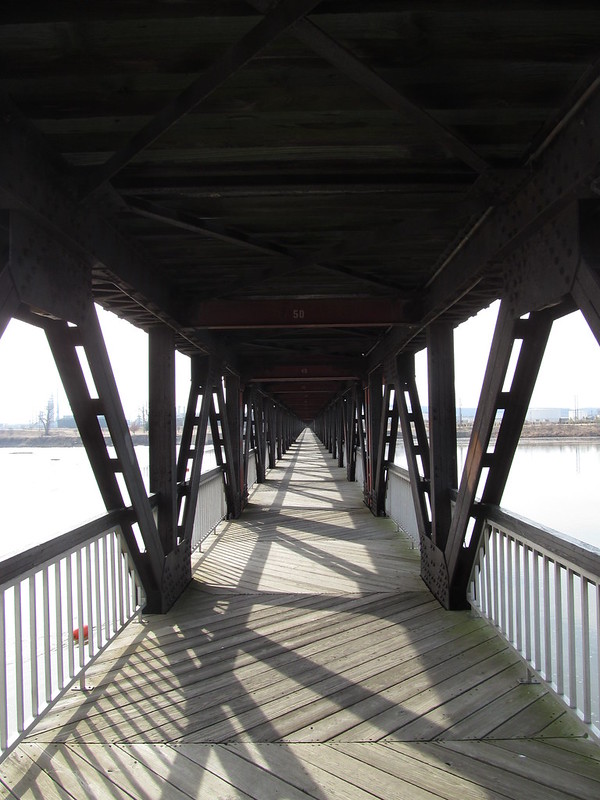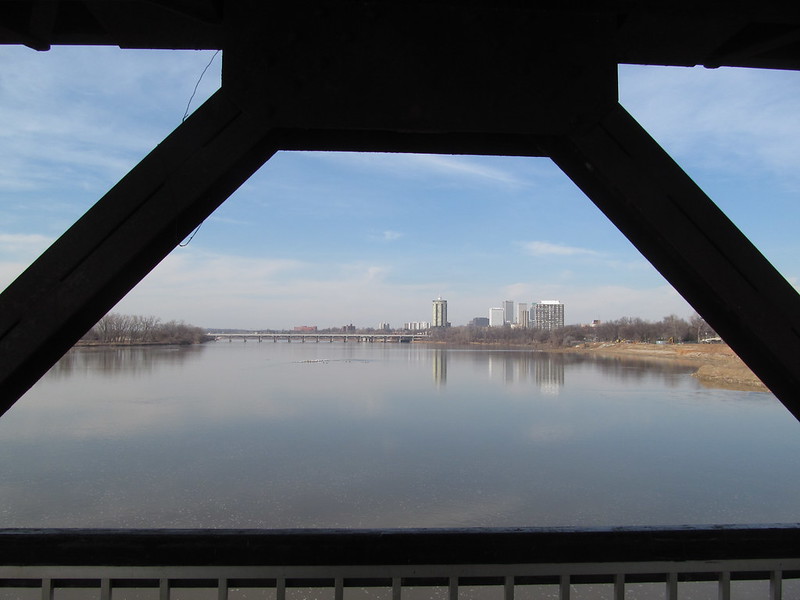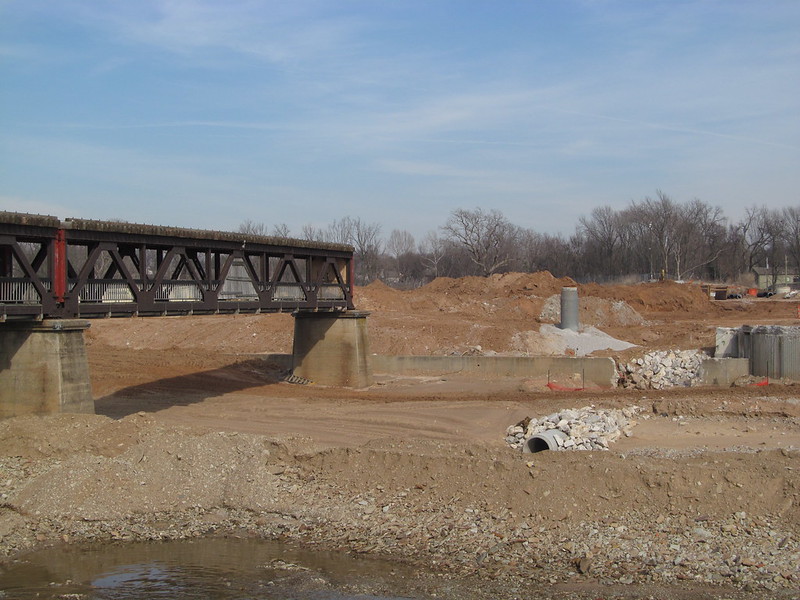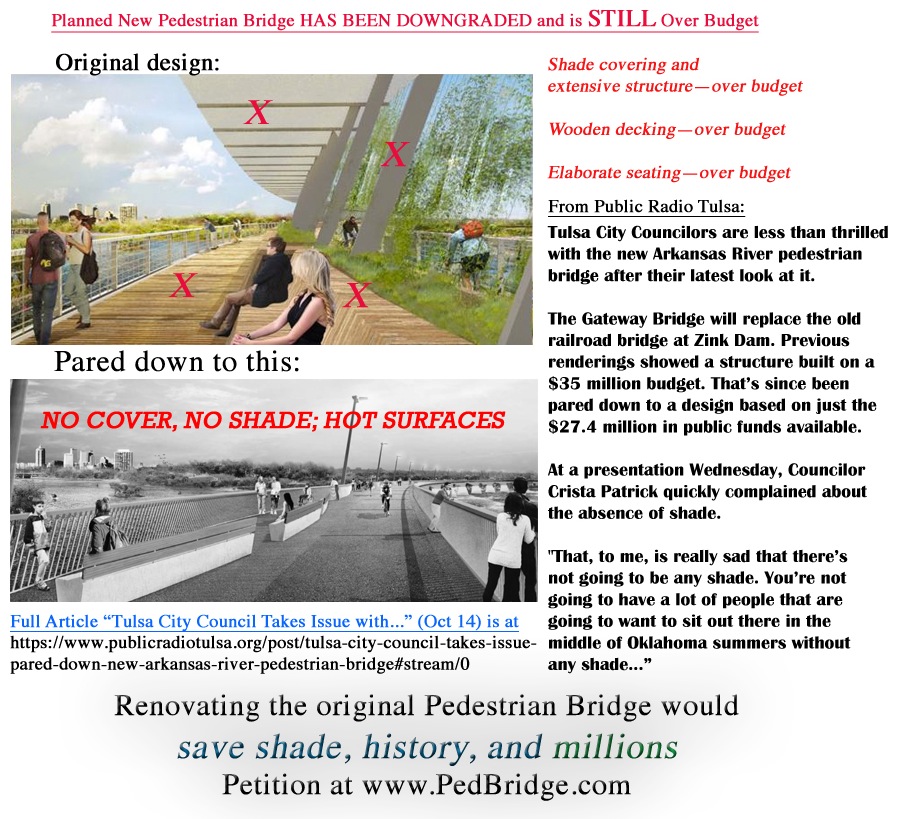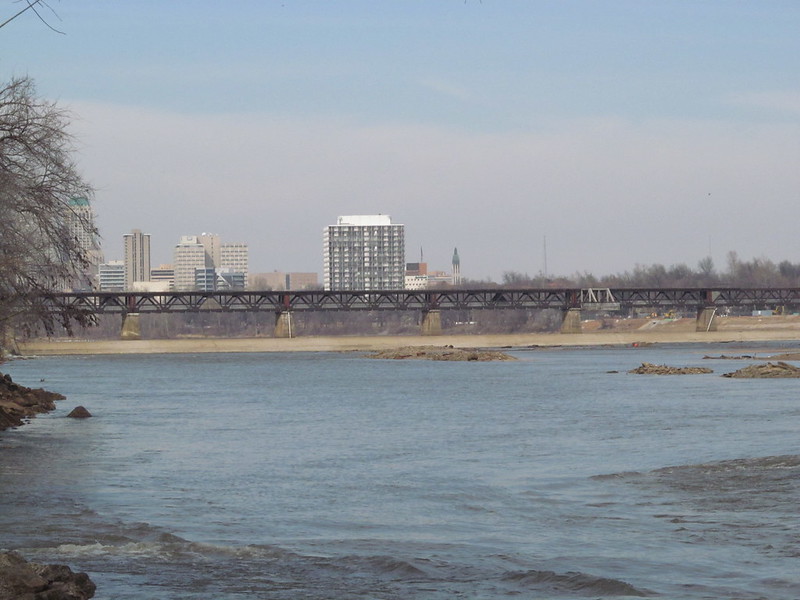Preserve the Midland Valley Pedestrian Bridge
Resistance is gathering to the plan to demolish the Midland Valley Pedestrian Bridge across the Arkansas River. Although an engineering analysis from 2015 shows that the 110-year-old railroad bridge is safe for its pedestrian use and can be affordably rejuvenated for another century, the Powers That Be want a monumental, starchitect-designed new bridge that will sweep majestically into the new private park on the east bank of the river. The City of Tulsa amputated the eastern landing of the historic bridge to conform to a private entity's preferences for the design of Riverside Drive.
Tulsan Jonathan Pinkey has been leading the charge to preserve and refurbish the Midland Valley bridge. He has initiated an online petition, a website, and a Facebook page as focal points for opposition to replacement of this historic bridge with an inferior substitute.
In April 2016, City of Tulsa voters approved a sales tax to pay for "economic development" projects. Title 43-K, the ordinance controlling the expenditure of those funds, set aside $63,000,000 for "Zink Lake and Related Amenities; Low-Water Dam with Recreational Gates & Flume and New Pedestrian Bridge; Mitigation, Bank Stabilization & Outfall Protection."
The Midland Valley bridge is historical in its own right as a railroad bridge, part of the rail link connecting Wichita and Tulsa with Bixby, Jenks, Glenpool, Muskogee and Fort Smith, but also as the first significant element of today's River Parks system. In 1974, the Missouri Pacific Railroad, which had acquired the Midland Valley in 1964, abandoned the bridge and its tracks north of the bridge. That same year the River Parks Authority was created by the Tulsa City Commission and the Tulsa County Commission, and the MoPac gave the bridge and the right of way to the City of Tulsa. This became the first segment of the Midland Valley Trail, from Riverside Drive to 21st Street. In 1975, the River Parks Authority raised funds with the help of the Tulsa Tribune to create a lower deck for pedestrians which initially extended only halfway across to an upper deck observation platform. These simple steps, connected with an older gravel jogging path from 11th Street to 56th Street on the east bank of the river, were the beginnings of the Arkansas River as a place of recreation for Tulsa residents. (The KRMG Great Raft Race, inaugurated on Labor Day 1973, was an important milestone in that regard.) A few years later, agreements were made with the Texaco Refinery, whose property extended to the west approach of the bridge to allow the completion of the pedestrian underdeck with connection to a west bank trail.
All of these early steps were taken without an added local tax burden. In 1969, Tulsans had rejected, 71%-29%, a bond issue to pay for the grandiose River Lakes Park plan for three low-water dams and a shopping concourse over the river. They also rejected funds for Riverside Expressway, which would have used the Midland Valley right-of-way to link Riverside to the southeast junction of the Inner Dispersal Loop. (My January 2007 Urban Tulsa Weekly feature story on the Arkansas River details the long history of Tulsa's river development proposals.)
I can remember visiting the pedestrian bridge when it was new and only extended halfway. It seems like every couple of weeks our 7th & 8th grade boys' P. E. class would take the school's bus to a more interesting place to run than the usual block around our neighborhood, and the Pedestrian Bridge at River Parks was one of those destinations.
The bridge offers a shaded respite for walkers and runners and great views upstream towards downtown and downstream towards Turkey Mountain.
The Midland Valley bridge is an early Tulsa example of adaptive reuse of historic resources. Tulsa has an unfortunate pattern of preferring to demolish history and build from scratch; this bridge stands as a testament that a better way is possible.
A 2015 engineering report from HNTB provides information that the existing bridge could be renovated for less than the planned cost of building new.
The Tulsa Whirled story on the bridge preservation effort is full of revealing tidbits. As you would expect, the Voice of the Cockroach Caucus is going to devote most space for those who want to spend more money and destroy history in the process.
When City Engineer Paul Zachary talks about the cost of renovating the existing bridge, he's including the price of upgrades -- a newly resurfaced upper deck with approaches for cyclists.
"It was our desire to use the existing bridge, that's what our plan was," Zachary said. "We like the way it looked. It was a neat-looking bridge, but what we had to realize was, if we did rebuild it being the way it was, we would still have a substandard trail width for the pedestrians and not necessarily the (required space) for bicyclists up on top."
Maybe shade and history are more important to Tulsans than trail width and bike lanes.
Another factor to keep in mind, Zachary said, is that the Gateway Bridge is designed not only to complement the Gathering Place design but to flow seamlessly into the park's west entrance. That is not the case for the existing bridge.
Maybe the Gathering Place should have planned around the existing bridge instead of designing for a non-existent bridge.
The HNTB 2015 report estimated a range of $17.5 to $19.9 million which would include the upgrades. Eliminate the upper bicycle deck and, according to a back-of-the-envelope calculation based on the HNTB report, the cost would drop to about $10.5 million, less than half of the $27.4 million budgeted for the new bridge.
It's funny, too, that Zachary is excited about a new bridge with a 75-year design life to replace a bridge that has been standing for about 110 years.
But even with the upper cycling deck, rehabbing the existing bridge is a significant savings over the new bridge, which will lack the shade, wooden decking, and enhanced seating originally promised.
Even at the higher $35 million budget, the new bridge plans didn't include adequate shade.
Tulsa's Gathering Place LLC Director and Trustee Jeff Stava is overseeing the bridge project. He said shade structures on pedestrian bridges are uncommon, and this one would have to be built to withstand winds up to 75 mph."The very cheapest shade structure that would be safe ... was around $5 million or $6 million, and that one really didn't provide enough shade. It wasn't a continuous shade. It was really more like if you've ever been under kind of like a pergola," Stava said.
Which is funny because the existing bridge has withstood 110 years of all kinds of weather, including major floods. 45 of those years have been in the current configuration, with the modifications related to the added lower deck.
This planned new bridge is being funded by the public, but all the decisions are being made and the project is being handled by a private institution:
The man managing replacement of Tulsa's Arkansas River pedestrian bridge told a board that oversees sales tax-funded projects its estimated cost has fallen closer in line with its $27 million budget....The Gathering Place is handling the brige [sic] project on behalf of the City of Tulsa.
Gateway Bridge was designed by Michael Van Valkenburgh Associates, the same firm that designed the Gathering Place.
Please sign the petition, contact your City Councilor, and show your support for preserving this beloved piece of Tulsa's Arkansas River transportation and recreation heritage.
MORE: The OKBridges website has a page dedicated to the Midland Valley Arkansas River bridge, with photos from before the destruction of the 1937 Riverside Drive viaduct and the easternmost span of the bridge.
Photos copyright 2016 by Michael D. Bates, taken on February 14, 2016, after the start of construction on Riverside Drive and the Gathering Place, when the bridge was still accessible from the west bank. 2016 Tulsa's Arkansas River album on Flickr.
0 TrackBacks
Listed below are links to blogs that reference this entry: Preserve the Midland Valley Pedestrian Bridge.
TrackBack URL for this entry: https://www.batesline.com/cgi-bin/mt/mt-tb.cgi/8762
